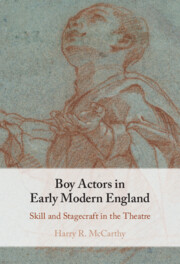Book contents
- Boy Actors in Early Modern England
- Boy Actors in Early Modern England
- Copyright page
- Dedication
- Contents
- List of Illustrations
- Acknowledgements
- Textual Note
- List of Abbreviations
- Introduction
- Chapter 1 ‘All Feats of Activitie, and Motions’
- Chapter 2 Staging Skill
- Chapter 3 ‘The Bettering of the Body’
- Chapter 4 ‘Sport Indeede’
- Conclusion
- Bibliography
- Index
Chapter 1 - ‘All Feats of Activitie, and Motions’
Rethinking Early Modern Boyhoods
Published online by Cambridge University Press: 25 August 2022
- Boy Actors in Early Modern England
- Boy Actors in Early Modern England
- Copyright page
- Dedication
- Contents
- List of Illustrations
- Acknowledgements
- Textual Note
- List of Abbreviations
- Introduction
- Chapter 1 ‘All Feats of Activitie, and Motions’
- Chapter 2 Staging Skill
- Chapter 3 ‘The Bettering of the Body’
- Chapter 4 ‘Sport Indeede’
- Conclusion
- Bibliography
- Index
Summary
This chapter provides a thorough revision of the status of boys and youths in the early modern period, attending to the neglected question of physical skill and training. It argues that attending to historically situated forms of physical expectation can shed light on how particular bodily skills are culturally cultivated, placing a more active emphasis on boys' bodies than scholars of early modern culture have typically tended to. The chapter draws on religious writings, conduct books, memoirs, apprenticeship manuals, and educational tracts in order to provide a wide-ranging picture of how boys' physical capacities were understood, improved, and manipulated in this period. Examining the ways in which boys and their bodies are situated in these works – often with an emphasis on physical labour and potential for activity – the chapter argues for a shared culture of expectation around the bodies of early modern boys in which physical movement and productivity is at the forefront. This culture, it moves to suggest, is everywhere discernible in contemporary attitudes to the early modern theatre, which articulated a pervasive fascination with the moving, working bodies of boy performers.
- Type
- Chapter
- Information
- Boy Actors in Early Modern EnglandSkill and Stagecraft in the Theatre, pp. 24 - 56Publisher: Cambridge University PressPrint publication year: 2022



